List of Authors
>>About this blog
Recent blog post
|
[Dimini ☆ Cricket]
April 18, 2018 12:00
"I can produce my own course ." ."
Such a fun project is being held at the Chuo Ward Social Education Center.
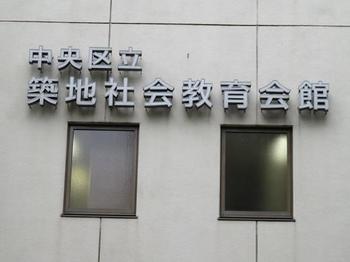
"Yume course" is course that inhabitants of a ward plan, propose and realize, and teaches each other and learns each other.
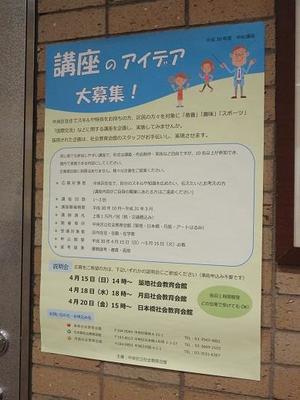
The briefing will be held on the following schedule.
Unfortunately, there are some halls where the briefing has already ended, but you can take the briefing at any hall.
Tsukiji Social Education Center; About 1 hour from 2:00 pm on April 15 (Sun)
Tsukishima Social Education Center; About 1 hour from 6:00 pm on April 18 (Wednesday)
Nihonbashi Social Education Center; About 1 hour from 3:00 pm on April 20 (Fri)
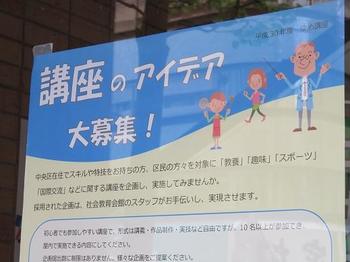
Contents include explanations of application guidelines and distribution of application documents.
Participation fee is free. 
You don't need to make a reservation.  
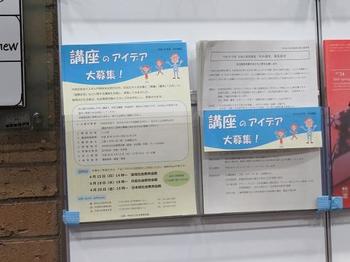
On this occasion, why don't you plan and realize the courses you wanted to do on your own?
In addition, we received your consent  regarding photography in the hall. regarding photography in the hall.
Click here for the website of the "Yume Course" information at the Chuo Ward Social Education Center ⇒
http://chuo-shakyo.shopro.co.jp/news/2018-04-15/post_3843.php
     
[yaz]
April 17, 2018 18:00
An art manhole is at your feet!
As you walk around the city, you will see many manholes on the road. We will also discover highly designed items with symbols and famous places of the city. A collector with a manhole cover as a card There is also a card called a manhole card that ticks the soul. Unfortunately, there is no manhole card with the Chuo-ku emblem, but if you visit the facilities of the Tokyo Metropolitan Sewerage Bureau, you can get the following manhole card for Tokyo's 23 wards free of charge.
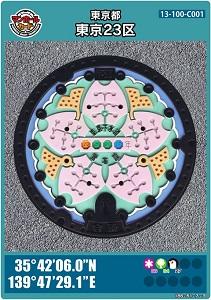
By the way, this card is "Kuramae Water House" (2-1-8 Kuramae, Taito-ku, Northern Sewerage Office TEL:: 03-3241-0944) It will be distributed free of charge to facility visitors. You need to make a reservation at least one week in advance.
There are various manholes such as water and sewage, telephone, electricity, fire department, etc., so why not walk down thinking of a "manhole cover" and walking down?
1. Manhole cover
There are currently two types of manhole materials: "FC" (cast iron) and FCD (FCD contains ductile or spherical black lead cast iron). FC200 is used for manholes under 14 tons, and FCD500 is often used for 20 tons of on-site manholes. In the groundman hall for roads, the lid is FCD700 and the frame is FCD600.
Before cast iron or spherical graphite cast iron manhole cover, the lid was concrete and the formwork was FC. The number is small, but it is still seen.
2. Manhole with Tokyo Chapter
I walked around Nihonbashi, Ginza, and Tsukiji, but more than 90% had a Tokyo chapter, and the design was a manhole for sewerage based on cherry blossoms. The Tokyo flower "Yoshino cherry tree", the tree "Ginkgo", and the bird "Yurikamome" are designed. Yoshino cherry tree is large in the center, with ginkgo leaves between the petals, 13 white gulls surrounding them.
You can also see a fire hydrant manhole (with a capital emblem) designed with a fire engine, and a manhole of the Tokyo Metropolitan Bureau of Transportation near the intersection where the signal control mechanism is located.
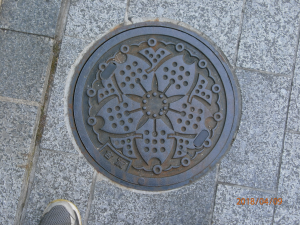 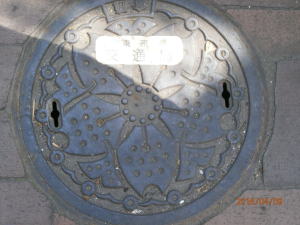 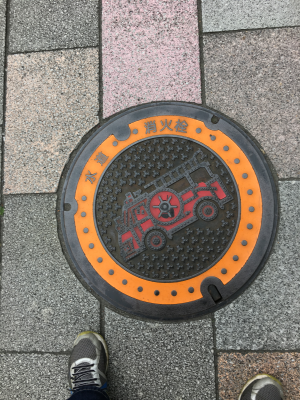
3. Manhole cover that decorates trees and flowers in Chuo-ku:
To commemorate the 40th anniversary of the central ward system, "Yanagi" and "Azalea" were enacted in 1987 as trees and flowers of the ward. To commemorate this, the colorful manhole cover installed in Chuo-ku is particularly noticeable. This manhole is on a downward trend, and it was said that it was about 2-3 years ago in Ginza 4-chome Wakoura and 5-chome Hatoido, but as far as I saw the other day, this manhole has been removed . I found this manhole cover near the Bank of Japan (2-1-1 Nihonbashi Honishicho). A willow is entangled in the azalea. It's precious. Since there is the word "light", it is a manhole where streetlight wires are placed.
 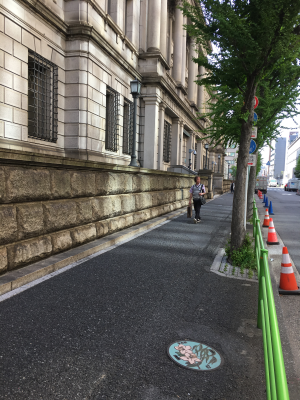
The photo of the sidewalk looks toward Kanda and the left is the Bank of Japan.
Although it is not colorful, I found a manhole (human hole) with the Chuo-ku emblem near Fukutoku Shrine (Nihonbashimuromachi).
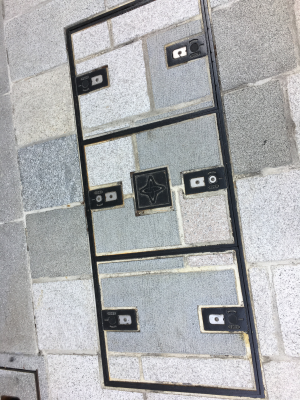 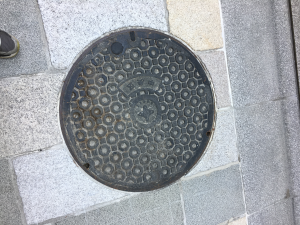
The cherry blossoms have fallen, but the manholes do not disappear. Have fun.
[Tokyo Dumbo]
April 16, 2018 18:00
Buyodo is a map specialty store located on the second basement floor of the Byoo Building, facing Yaesu Kitaguchi Street, one further east of Sakura-dori St. on the east side of Nihonbashi Takashimaya, and is called "Treasure Island of Map".
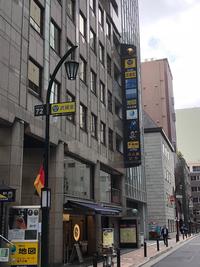 
This company was established in 2007, inheriting the publishing and bookstore sales department of Takeyodo Co., Ltd., which was founded in 1897 (Meiji 30). It seems that Takeage-do was handling Army books before the war, but since the war, he has been conducting agency work to dealers nationwide as a source of topographic maps issued by the Geographical Survey Institute.
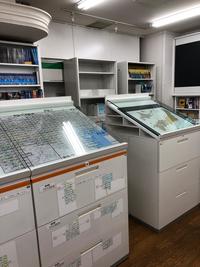 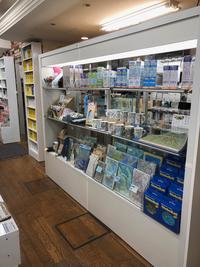
In addition to publishing company publications such as road maps, books and map calendars related to maps, "Ino-zu" created by Tadataka Ino, a map creator of the Edo period, as well as selling theme maps such as volcanic land conditions maps and urban active fault maps, overseas maps, housing maps and old maps, as well as selling map goods and processing panels and framed services.
Tokyo Danbo purchased a map of Chuo-ku in 1935. There are also maps that express topographic maps in 3D and mugs that print old Edo maps, and there are plenty of things you want.
stamp rally is held from April 9th (Mon) to April 28th (Sat), with seven antenna shops in the Nihonbashi area, Takashimaya, Mitsukoshi, Eitai, and ROJI.
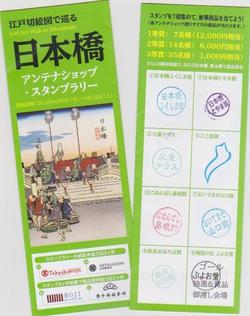 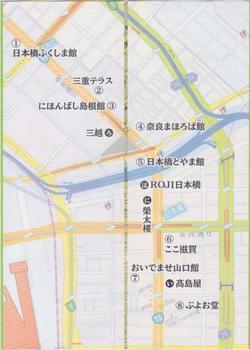
If you go around the seven antenna shops in Yamaguchi, Shiga, Toyama, Nara, Shimane, Mie, and Fukushima along Chuo-dori across Nihonbashi, you will get a little sweets that can recover tiredness from Eitai and ROJI. You can draw lots of lottery at Buyodo.
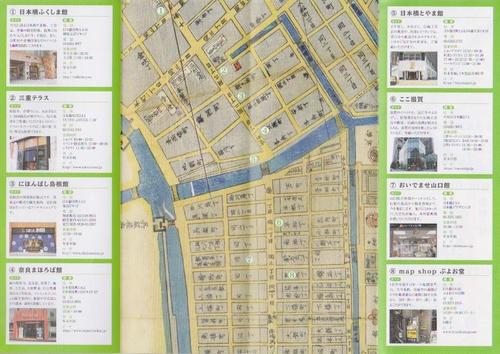
It is a fun event where you can take a short walk on Chuo-dori while comparing the cut-out map with the current map and try lottery. There are still many prizes left, so please join us and take a look.
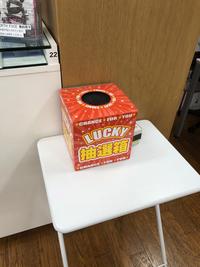 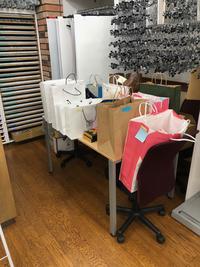
Mr. Okazaki, Director of Buyodo, who heard this time, will continue to work on all employees to pursue their historical value, new roles, and positions without temporarily stagnating the publishing culture, especially the culture of maps. He said that he would like to focus on paper-based maps.
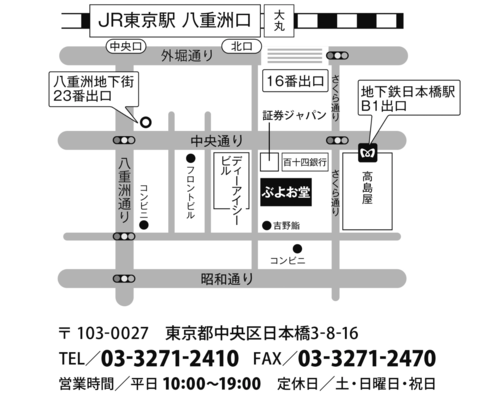
[Asunaro]
April 16, 2018 12:00
When "Nihonbashi" is written in Roman letters.
If Japan is Nihon, it will be Nihonbashi.
I guess. Still, Roman letters are displayed at the place where they are posted.
So it's different. For example, a signboard on the sidewalk could be used.
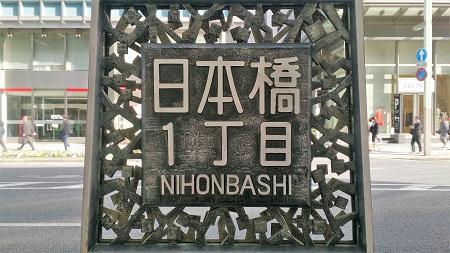
On the other hand, the station name is displayed.
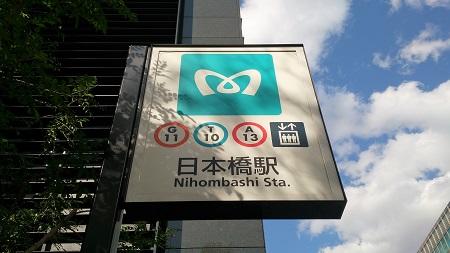
In Roman letters, the sound repellency "n" is represented by n, but
There is a format that makes the sound repellency before b, m, and p m.
In the case of Nihonbashi, "ba" continues next, so it will be m.
The bar line is pronounced in a closed shape with both lips.
The "n" just before that is the idea of m.
「Nihombashi」
It is written according to actual pronunciation and is easy to read for English-speaking people.
I think it's right. I don't particularly distinguish sound repellency in Japanese.
This writing may be unnatural.
Think about who the display is for.
You have to choose it.
[Dimini ☆ Cricket]
April 14, 2018 12:00
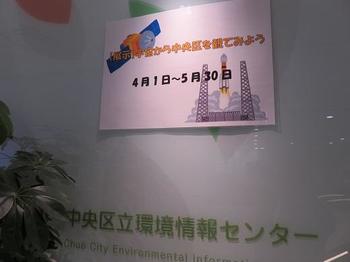
Currently, an exhibition entitled "Let's see Chuo-ku from Space" is being held at the Chuo Ward Environmental Information Center exhibition space in the Kyobashi Environmental Station on the 6th floor of Tokyo Square Garden in Kyobashi 3-chome.
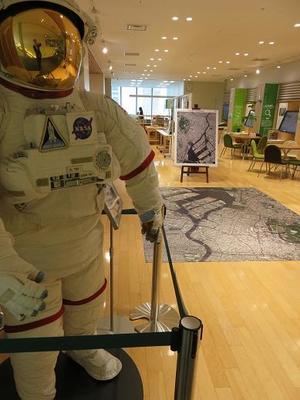
The event period is from Sunday, April 1 to May 30 (Wed).
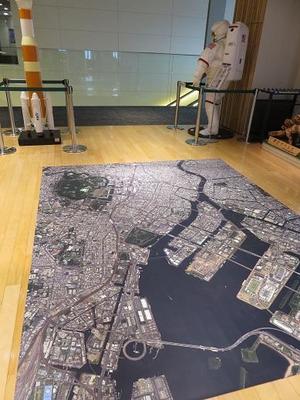
The time is from 9:00 to 21:00, so it's okay to stop by on your way home.
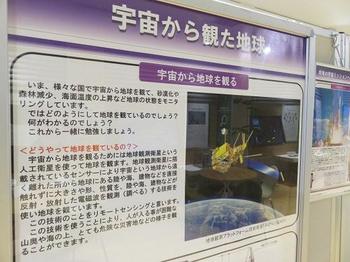
This is supported by the Japan Aerospace Exploration Agency (JAXA), where satellite photos of Chuo-ku and methods for observing the global environment from space are displayed on panels and models.
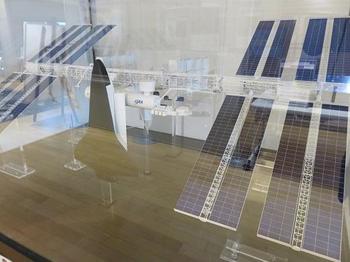
The explanation of the panel was easy to understand, and the model was real and very interesting.
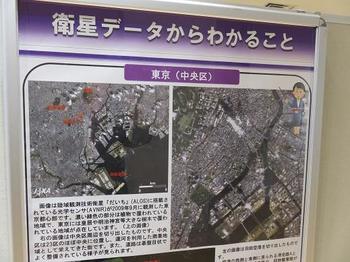
This exhibition is also being held during GW, so it would be nice to stop by with your family.
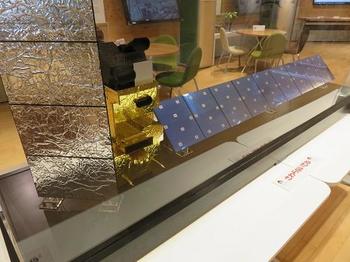
In addition,  we received your consent regarding photography in the exhibition space. we received your consent regarding photography in the exhibition space.
Click here for the website of the Chuo Ward Environmental Information Center ⇒
https://eic-chuo.jp/
     
1.
April 13, 2018 16:00
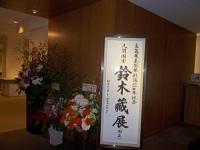
The above exhibition started on April 11 as part of the 110th anniversary of the Takashimaya Art Department's founding, and immediately came to the museum on the first day.
As you all know, Mr. Kura Suzuki is a ceramic artist representing Hyundai Shino, who was certified as an important intangible cultural property holder (living national treasure) of Shino in 1994. The exhibition at Takashimaya has been a new exhibition for the first time in nine years since 2009, not only Shino, but also Seto black, vases, and books. This time, the subtitle "Shigahi, Become Nature" is a word in Basho's "Oi no Kobun", and it seems that "easy flow", which is said to be the characteristic of Basho haikai, was born.
There are many works with different tendencies from the past, and when you slowly look at "If you can buy it, this is good", the person in charge said, "Please pick it up", and the words are sweet and powerful When you put a large bowl on your hand, there is no weight that you can imagine from the size of the appearance, and "The green looks like it looks like it looks like it looks like it." How delicious it will be with this," he sighed. I was able to talk a little with my teacher, and it was a happy day. If you don't have the luck of the lottery, you can't buy it, but I'd like to see it again just by looking at it.
"Suzuki Kura Exhibition" Takashimaya Nihonbashi 6th floor art gallery until April 17th
|
Links
|
![]() ."
."![]()
![]()
![]()
![]()
![]()
![]()
![]()
![]()
![]()
![]()
![]()
![]() regarding photography in the hall.
regarding photography in the hall.![]()
![]()
![]()
![]()
![]()
![]()
![]()
































